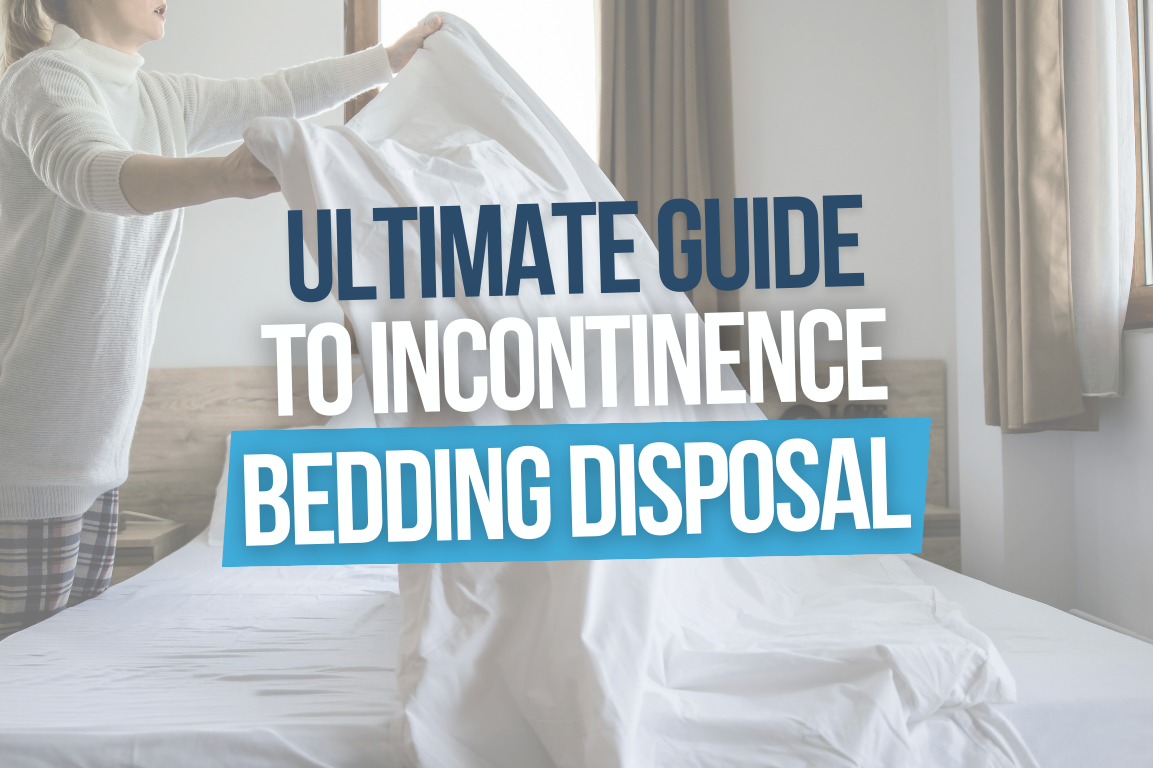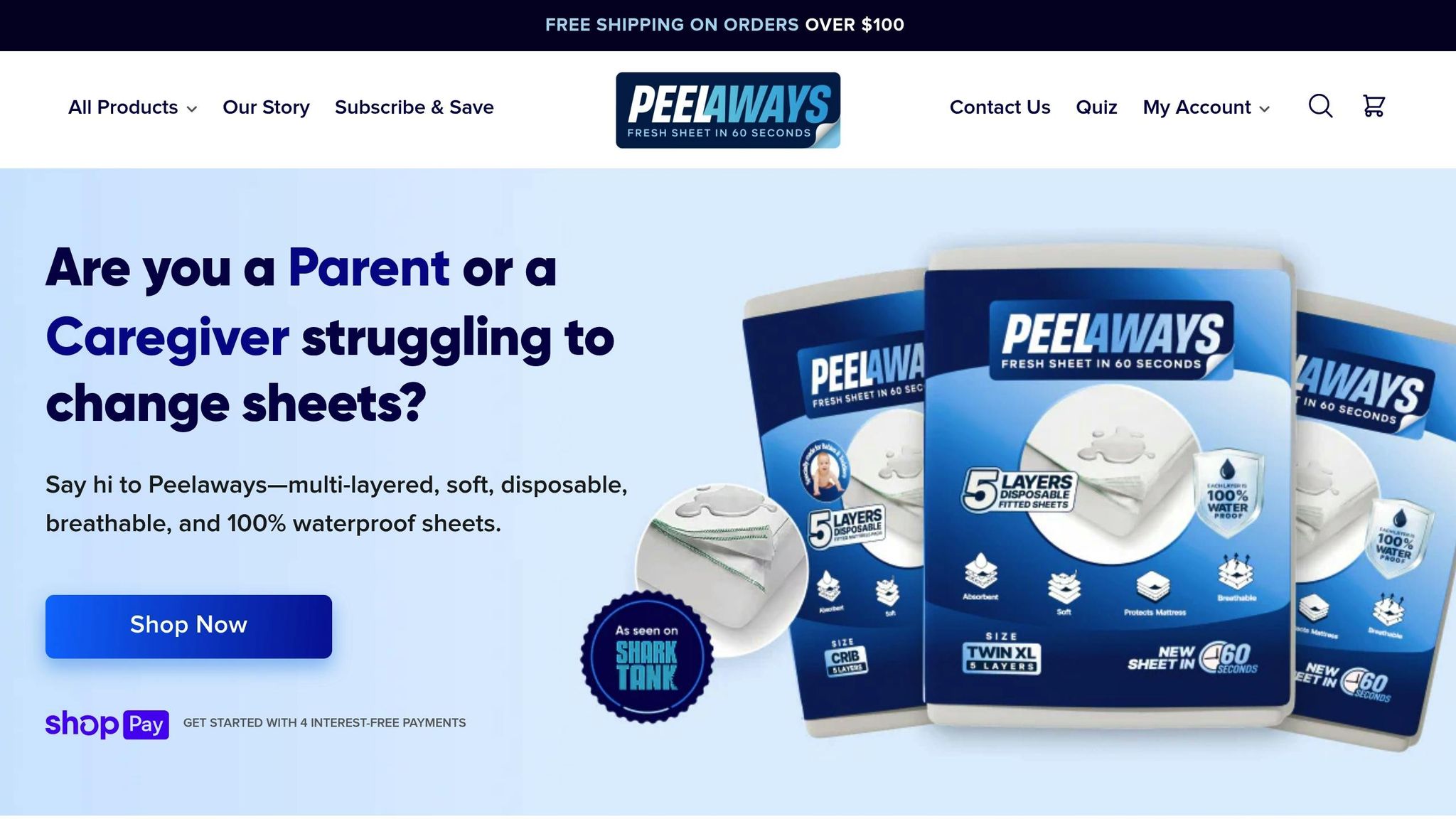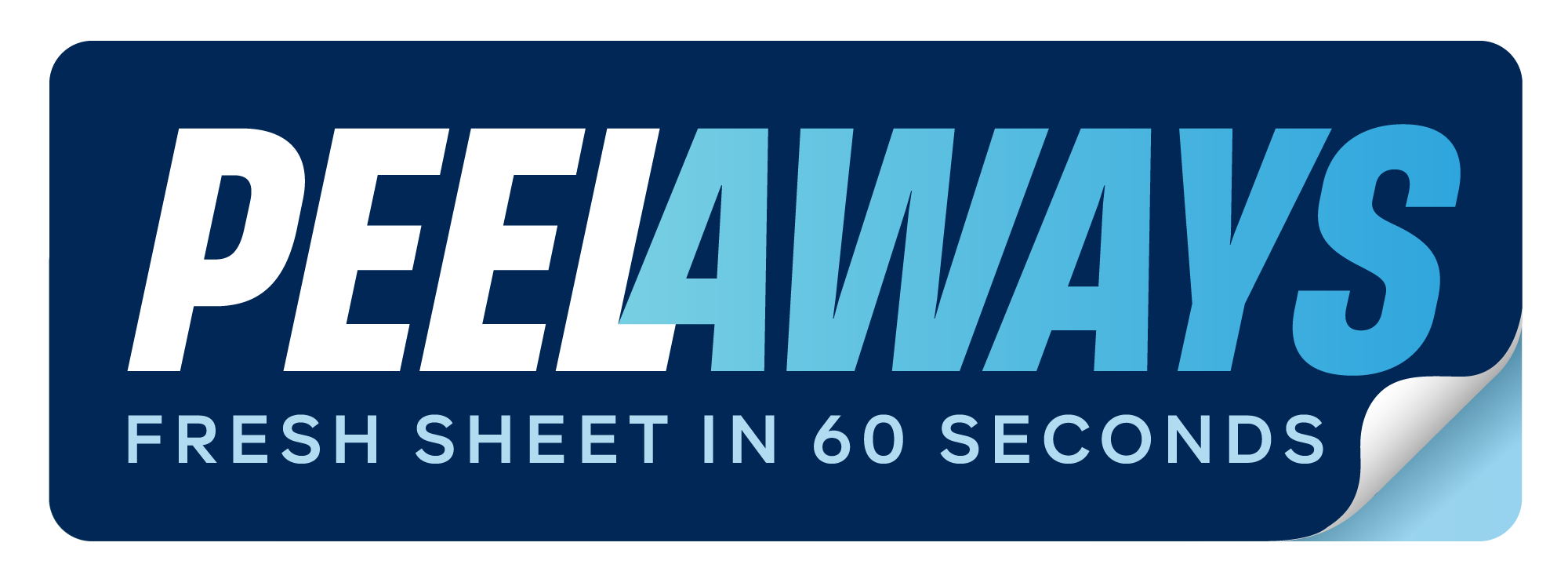Ultimate Guide to Incontinence Bedding Disposal

Dealing with incontinence bedding can be challenging, but proper disposal is key to maintaining hygiene, safety, and comfort. Whether you're a caregiver at home or in a healthcare setting, understanding how to handle soiled bedding effectively is essential for preventing health risks and reducing odors. Here's what you need to know:
- Health Risks: Soiled bedding can spread bacteria quickly, leading to cross-contamination and skin irritation.
- Disposal Options: Disposable pads, washable bedding, and multi-layered PeelAways each have unique handling and disposal needs.
- Step-by-Step Process: Use gloves, remove solid waste, bag securely, and follow local waste regulations.
- Environmental Impact: Biodegradable options and products like PeelAways help reduce waste while simplifying cleanup.
Products like PeelAways offer a practical solution by allowing you to peel off soiled layers without heavy handling or immediate washing. Whether you choose disposable or washable options, the right approach can save time, reduce stress, and create a cleaner, more comfortable environment.
How to use the Janibell Akord Incontinence Disposal System
Types of Incontinence Bedding
Choosing the right incontinence bedding is essential, as each type comes with unique care and disposal needs to ensure hygiene and safety.
Common Bedding Options
One of the most popular choices for incontinence bedding is underpads, often called bed pads or Chux pads [1]. These protective layers act as a barrier, shielding mattresses, furniture, or wheelchairs from leaks. They’re designed to prevent fluids from seeping into surfaces, making cleanup easier.
Disposable bed pads are made with an absorbent polymer core, a soft top layer, and a waterproof backing. Some even include adhesive strips to keep them securely in place. These pads are single-use, offering convenience for caregivers, especially when time is limited. Many advanced versions also feature odor-control and moisture-wicking technologies, adding an extra layer of comfort and functionality.
Washable bed pads, on the other hand, are crafted from durable, multi-layer fabrics with waterproof backing. They’re designed for repeated use, often treated with antibacterial finishes, and may include quilted tops for added comfort. To prevent shifting, some models come with textured undersides or non-slip grips. Though they require washing after each use, they’re a more economical option for long-term care.
Another option is PeelAways, which takes a unique approach to incontinence bedding. These disposable, waterproof bed sheets feature a patented multi-layer design, with 5 to 7 absorbent layers depending on the size. When the top layer becomes soiled, caregivers can simply peel it away to reveal a fresh layer underneath. This reduces handling and minimizes the risk of cross-contamination.
Each of these bedding options presents different challenges when it comes to handling and disposal, making proper practices essential.
Health and Hygiene Risks
The way incontinence bedding is disposed of has a direct impact on health and hygiene. Soiled bedding can quickly become a breeding ground for bacteria, increasing the chances of cross-contamination and skin irritation. Single-use options like disposable pads or PeelAways can help mitigate these risks by allowing for immediate disposal.
Cross-contamination is a major concern during bedding changes. Traditional methods often require caregivers to handle soiled items directly, strip beds, and transport contaminated materials through shared spaces. Each step increases the likelihood of germs spreading to clean surfaces or other individuals.
For reusable bedding, delays in washing can lead to lingering odors and an uncomfortable environment. Moreover, prolonged exposure to damp materials can irritate the skin, causing rashes, pressure sores, or other skin issues - especially for individuals with limited mobility.
Ultimately, the disposal method you choose plays a key role in managing these risks. Single-use options like disposable pads and PeelAways reduce many contamination concerns, while reusable bedding demands careful handling and timely washing to maintain a safe and clean environment.
Step-by-Step Disposal Procedures
Disposing of incontinence bedding properly requires careful preparation and a structured approach to ensure hygiene and prevent contamination. These steps help safeguard both caregivers and care recipients while maintaining a clean environment.
Preparing for Disposal
Before handling soiled bedding, it’s important to wear personal protective equipment. As WellBefore advises, "Consider utilizing a pair of disposable gloves prior to starting the process." [2] Gloves are essential, and having hand sanitizer nearby allows for quick sanitation if needed, even while gloves are on.
If the bedding contains solid waste, remove it first. WellBefore recommends, "If there is any fecal matter, dispose of it into the toilet and flush them out to reduce the smell coming from the diaper." [2] This step minimizes odors and prepares the bedding for easier handling.
For added hygiene, use cleansing wipes during perineal care to reduce contamination. If you’re using PeelAways bedding, the process is more straightforward - simply peel off the soiled top layer while wearing gloves to reveal a clean layer underneath, limiting exposure to the soiled material.
Once the bedding is ready, secure it tightly to prevent leaks and odors during transport.
Proper Bagging and Containment
Effective folding and rolling techniques are key to safely containing soiled bedding. For disposable pads and traditional bedding, start folding or rolling from the soiled end, keeping the material tightly secured to prevent it from unraveling. As NorthShore Care Supply points out, "wrapping can help contain the odors from a soiled diaper." [3]
Use durable, sealable plastic bags to contain the bedding. For heavily soiled items, double bagging provides extra protection against leaks and odors. Scented bin bags can also help mask unpleasant smells.
Once the bedding is securely bagged, it’s ready for disposal.
Disposal Options for Homes and Facilities
After sealing the bedding, choose a disposal method based on local regulations. For home disposal, place sealed bags in regular household waste bins, but never flush bedding down the toilet. Even small fabric pieces or padding can cause plumbing issues and damage municipal water systems.
To manage odors between trash collection days, use airtight disposal bins with liners. If disposing of bedding in public trash bins, ensure it’s sealed in disposable bags to maintain sanitary conditions in shared spaces.
Healthcare facilities often have stricter protocols. Many institutions use designated medical waste streams or specialized collection services for hygiene products. Always check with facility management to follow their specific procedures.
Finally, after handling soiled bedding, wash your hands thoroughly with soap and warm water for at least 20 seconds. Focus on areas around your fingernails and between fingers to ensure complete cleanliness and protection.
sbb-itb-45288fe
Preventing Cross-Contamination
Preventing cross-contamination is essential for maintaining health and safety. To stop bacteria from spreading, it’s important to use the right containment supplies. Start with a leak-resistant biohazard bag - and if the bag’s exterior becomes contaminated, punctured, or you're handling wet waste, double-bag it for added protection[4][5]. Additionally, puncture-resistant containers are a must to avoid accidental leaks or spills. These steps align perfectly with the cleaning practices we’ll touch on later.
For bedding, PeelAways offers a smart solution. Their design allows caregivers to simply peel away the soiled layer, cutting down on direct exposure to contaminants. This feature makes bedding changes safer and helps lower the risk of cross-contamination.
Modern Disposal Solutions
Modern disposal methods have come a long way, offering smarter and more efficient ways to handle soiled bedding. These advancements not only ease the practical challenges of incontinence care but also address growing concerns about environmental impact. Caregivers today have access to options that are both effective and mindful of the planet, making it easier to manage soiled bedding in homes and healthcare settings.
Biodegradable and Compostable Options
Traditional disposal often adds to landfill waste, but biodegradable bedding products are changing that narrative. These materials are designed to break down naturally over time, reducing their impact on the environment while still meeting the hygiene standards required for incontinence care.
That said, there’s a catch: while these products are biodegradable, bodily fluid contamination means they should still be disposed of with regular waste rather than home composting. Residential composting systems typically don’t reach the high temperatures needed to safely process contaminated materials.
However, commercial composting facilities are better equipped to handle these products. Some facilities accept biodegradable incontinence bedding as long as it’s properly bagged and labeled. It’s a good idea to check with your local waste management authority to see if such options are available in your area.
The main benefit of biodegradable bedding is its shorter environmental lifespan. Unlike traditional materials that can linger in landfills for decades, these products decompose within months, making them a smarter choice for reducing long-term waste.
In addition to these eco-friendly options, there are innovative products that make disposal even easier and more practical.
PeelAways: A Game-Changing Solution

One standout in modern disposal solutions is PeelAways, a product that completely reimagines how caregivers manage soiled bedding. With its clever, layered design, PeelAways eliminates many of the hassles associated with traditional bedding changes.
Here’s how it works: PeelAways sheets come with 5 to 7 layers, each functioning as a fitted sheet. When the top layer gets soiled, you simply peel it away to reveal a fresh, clean layer underneath. This eliminates the need to lift mattresses, reduces the urgency of immediate laundry, and significantly lowers the risk of cross-contamination.
Disposing of the used layer is simple. Just roll it up and toss it in the regular trash - similar to how you’d dispose of a diaper. Plus, because each layer is thin, it takes up less space in waste bags compared to bulky traditional bedding.
PeelAways are available in various sizes, with pricing options to suit different needs:
- Crib-A-Peel: $30.99 (for toddlers)
- King size: $53.99
- Cot and Twin XL sizes come with 7 layers, while Twin, Full, and Queen sizes feature 5 layers.
For those looking to save, subscription options offer a 15% discount and free shipping on orders over $100. There’s also a 30-day money-back guarantee and gift card options for added flexibility.
For caregivers managing multiple beds, whether at home or in healthcare facilities, PeelAways offers a practical and economical alternative. The reduced laundry needs mean savings on water and energy, while the breathable, waterproof fabric ensures comfort without compromising on protection. It’s a solution that balances convenience, cost, and care, making it a valuable choice for incontinence management.
Conclusion
Managing incontinence bedding disposal effectively comes down to having the right tools and practices in place. The focus should always be on balancing hygiene, safety, and environmental care while simplifying the process for caregivers.
Start with proper preparation: disposable gloves, leak-proof bags, and disinfectants are essential to limit exposure. Contaminated bedding should always be discarded with regular household waste to ensure safety.
To avoid cross-contamination, follow strict cleaning routines. Whether you're caring for a single individual at home or overseeing a larger group in a facility, thorough handwashing, surface disinfection, and securely containing soiled materials are critical steps to protect everyone involved.
Fortunately, modern innovations are simplifying disposal while reducing environmental impact. Biodegradable options, though not always compostable at home, help lessen long-term waste concerns. Products like PeelAways make the process even easier by offering a peel-and-dispose solution that eliminates the need for laundering. These advancements not only save time but can also lead to cost savings over time.
While traditional bedding may seem like a cost-effective choice upfront, frequent laundering adds hidden expenses. Constant washing, water use, energy costs, and the need to replace worn-out items quickly add up. Modern solutions that reduce these recurring costs often prove to be more economical in the long run.
Streamlined disposal methods also help ease caregiver stress. With efficient systems in place, caregivers can shift their focus from logistical challenges to providing quality care. Whether you stick to traditional practices with strict protocols or explore newer, innovative solutions, the ultimate goal is the same: ensuring cleanliness, dignity, and peace of mind for everyone involved.
FAQs
What’s the difference between disposable and washable incontinence bedding, and how does it affect disposal?
Disposable incontinence bedding offers the convenience of single-use, allowing you to simply toss it out after each use. While this eliminates the need for washing, it does create more waste. On the other hand, washable bedding can be reused multiple times, reducing waste but requiring regular laundering, which uses water and energy.
Choosing between these two options really comes down to what matters most to you. Disposable bedding is all about ease and speed, perfect for those who need a hassle-free solution. Meanwhile, washable bedding can save money in the long run and is kinder to the environment. Think about what fits your lifestyle, whether that's convenience, reducing waste, or balancing both.
What steps can caregivers take to prevent cross-contamination when disposing of soiled incontinence bedding?
Caregivers should always use disposable gloves when handling soiled bedding to reduce the risk of cross-contamination. It's best to place the bedding directly into a sealed laundry bag or the washing machine to keep any contaminants contained. Never shake the bedding, as this can release bacteria or particles into the air.
For extra precaution, using disposable, multi-layered waterproof sheets or mattress covers is a smart choice. These help trap fluids and cut down on the need to handle soiled materials frequently. By sticking to these practices, caregivers can limit exposure to bodily fluids and maintain a safer, cleaner environment.
What should I consider about the environment when disposing of incontinence bedding, and how do biodegradable options help?
When getting rid of incontinence bedding, it's essential to think about how the materials affect the environment and how long they take to break down. Biodegradable bedding is crafted to decompose more quickly than conventional options, which can help cut down on landfill waste and long-term pollution. That said, its effectiveness often hinges on proper disposal methods, like composting or using specialized facilities - options that might not always be readily available.
On the other hand, non-biodegradable bedding, typically made from plastics, can linger in the environment for centuries, adding to ongoing pollution problems. Opting for products that are designed to reduce waste - like multi-layered, disposable bedding - can be a practical way to lessen your overall environmental impact.
Related Blog Posts
- Disposable vs. Washable Bed Sheets: Comparison
- How to Choose Bedding for Incontinence Care
- How Disposable Sheets Reduce Cross-Contamination
- Preventing Odors in Incontinence Bedding: Tips and Tricks
Comments
0

SAVE MONEY & WATER
Professionals & Institutions save a fortune on labor/laundry.

SUPERIOR COMFORT
The first thing our customers notice is how soft our sheets are.

100% WATERPROOF
Each layer is 100% Waterproof, perfect for spills and accidents

SAVE TIME
Change the sheet in under 1 minute without stripping the bed.




Leave a comment